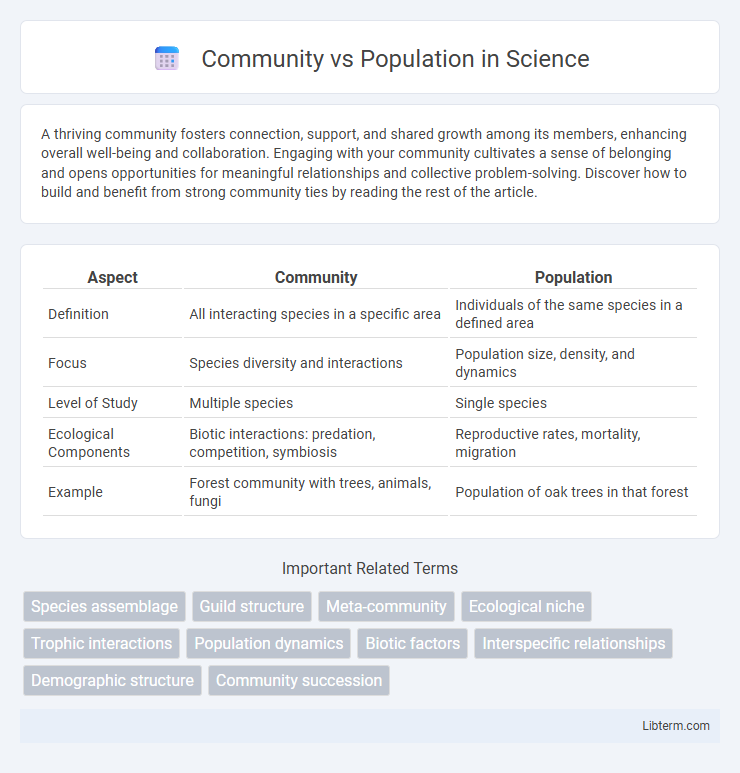A thriving community fosters connection, support, and shared growth among its members, enhancing overall well-being and collaboration. Engaging with your community cultivates a sense of belonging and opens opportunities for meaningful relationships and collective problem-solving. Discover how to build and benefit from strong community ties by reading the rest of the article.
Table of Comparison
| Aspect | Community | Population |
|---|---|---|
| Definition | All interacting species in a specific area | Individuals of the same species in a defined area |
| Focus | Species diversity and interactions | Population size, density, and dynamics |
| Level of Study | Multiple species | Single species |
| Ecological Components | Biotic interactions: predation, competition, symbiosis | Reproductive rates, mortality, migration |
| Example | Forest community with trees, animals, fungi | Population of oak trees in that forest |
Defining Community and Population
A community consists of multiple interacting species living together in a defined area, emphasizing biotic relationships and species diversity. In contrast, a population refers to individuals of the same species inhabiting a specific geographic location at a given time, focusing on their abundance and genetic composition. Understanding the distinction between community and population is essential for ecological studies involving interactions, dynamics, and resource distribution.
Key Differences Between Community and Population
A population consists of individuals of the same species living in a specific area, while a community includes multiple populations of different species interacting within an ecosystem. Populations are studied to understand species-specific dynamics like birth rates and genetic variation, whereas communities focus on interspecies relationships such as competition, predation, and symbiosis. Key differences include species diversity (single-species in populations vs. multi-species in communities) and the scope of ecological interactions examined.
Components of a Population
A population consists of all individuals of a single species living in a defined area, characterized by components such as size, density, dispersion, age structure, and genetic composition. Community, in contrast, encompasses multiple interacting populations of different species within the same habitat. Understanding population components is essential for studying species distribution, growth patterns, and ecological interactions.
Structure and Diversity of Communities
Community structure encompasses the variety and abundance of species living together in a defined area, reflecting complex interactions and ecological roles. Population refers to individuals of a single species within that community, characterized by factors like size, density, and distribution. Community diversity measures species richness and evenness, highlighting ecological balance and resilience against environmental changes.
Interactions Within a Population
Interactions within a population involve relationships among individuals of the same species, such as competition for resources, mating behaviors, and social structures. These interactions influence population dynamics, including growth rates, survival, and reproduction patterns. Understanding these intra-species interactions is crucial for studying population ecology and predicting changes in population size and distribution.
Interrelationships Among Community Members
In ecological studies, community refers to all interacting species living in a particular area, emphasizing the multitude of biotic relationships such as predation, competition, and mutualism among species. Population focuses on individuals of a single species sharing the same habitat, highlighting intraspecific interactions like mating, social structure, and resource sharing. Understanding these interrelationships within communities reveals complex networks that regulate ecosystem stability and biodiversity dynamics.
Population Dynamics and Growth
Population dynamics examine changes in the size and composition of populations over time, influenced by birth rates, death rates, immigration, and emigration. Unlike communities, which encompass multiple interacting species within an ecosystem, populations focus on a single species group occupying a defined area. Population growth models, such as exponential and logistic growth, describe how populations increase or stabilize based on resource availability and environmental constraints.
Community Structure and Ecosystem Roles
Community structure refers to the composition and arrangement of different species living together in a specific area, including their abundance, diversity, and interactions. Population denotes a group of individuals of the same species occupying a given space and time, primarily focusing on demographic factors such as size, density, and age distribution. In ecosystems, community structure influences trophic relationships and energy flow, while populations contribute to ecosystem roles through species-specific functions like pollination, predation, and nutrient cycling.
Importance in Ecology and Environmental Science
Community in ecology represents the complex interactions among different species living together in a shared environment, crucial for understanding biodiversity and ecosystem stability. Population refers to a group of individuals of the same species within a specific area, essential for studying species dynamics, reproduction rates, and resource competition. Both community and population analyses provide critical insights for environmental management, conservation strategies, and assessing ecosystem health under changing environmental conditions.
Practical Applications: Conservation and Management
In conservation and management, understanding the distinction between community and population is crucial for effective ecosystem planning. Population-level studies inform species-specific strategies such as breeding programs and habitat preservation, while community-level analyses guide the maintenance of biodiversity and ecological interactions across multiple species. Practical applications include designing protected areas that support both individual species' needs and overall ecosystem health, ensuring balanced resource use and resilience against environmental changes.
Community Infographic

 libterm.com
libterm.com